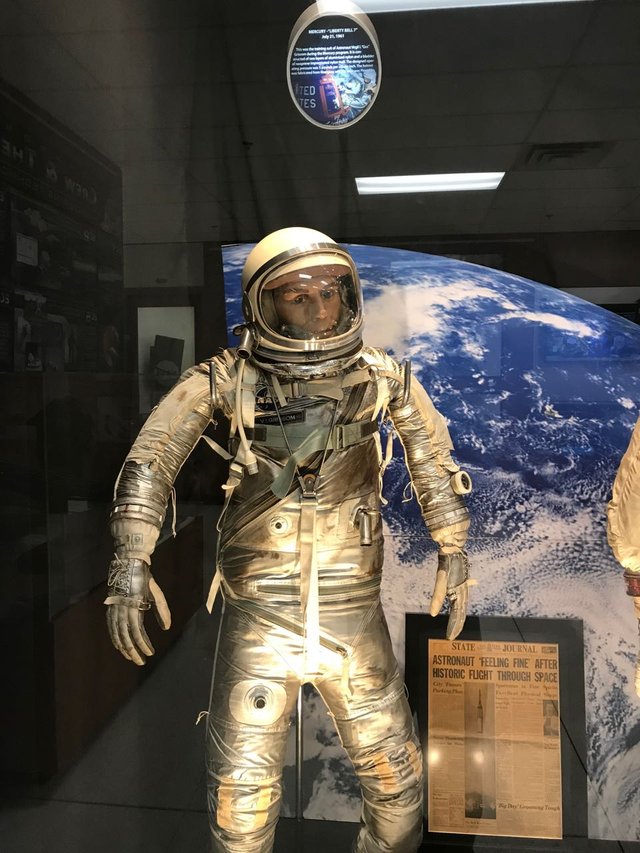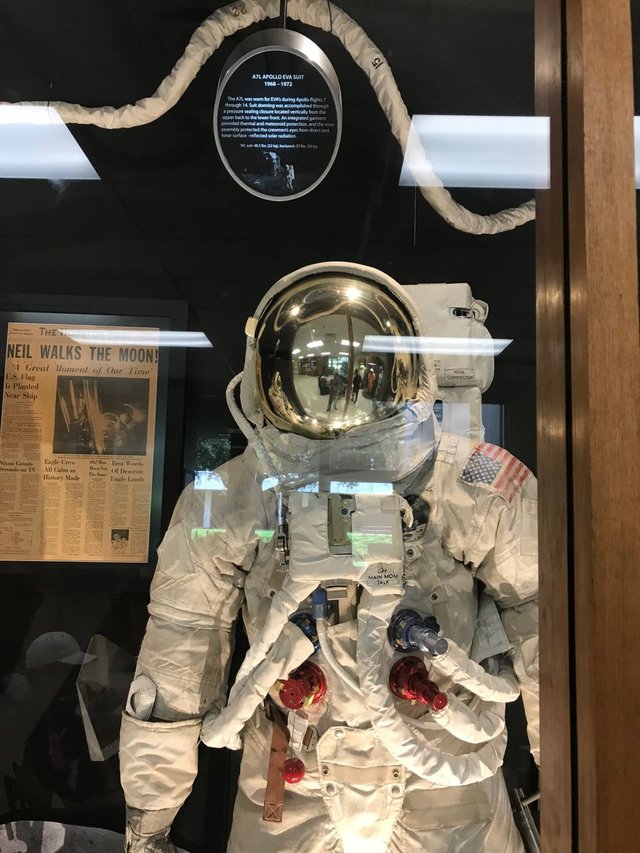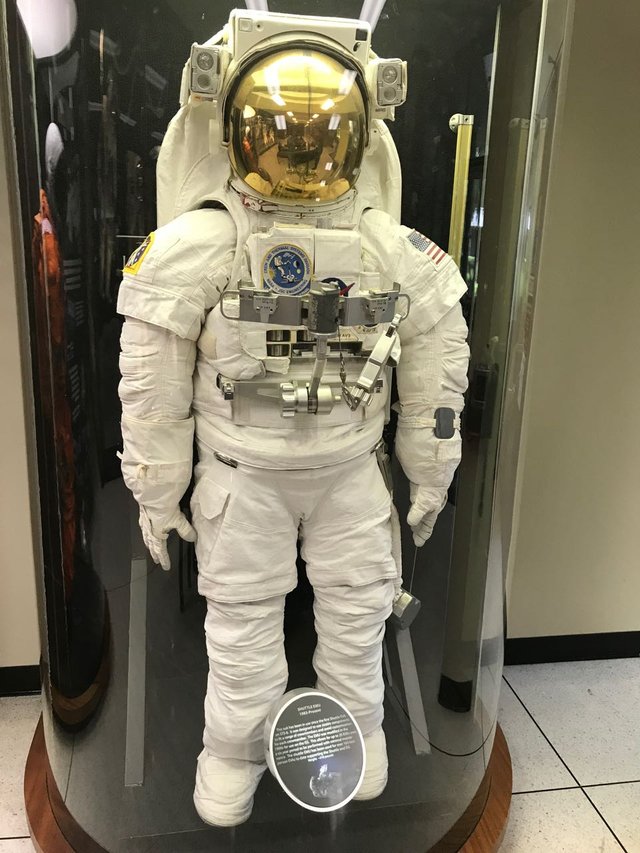Behind the Scenes Tour at NASA's Johnson Space Center, Part 3: Spacesuits
After rockets, spacesuits are perhaps the most visible sign of the space program and space exploration. In this part of our tour we saw the entire evolution of NASA spacesuits, from Mercury up through the present day. This post covers the entire collection. The plaques next to each suit give details that I've summarized in the description of each suit.
If you missed the first parts of our behind the scene tour be sure to check them out:
- Behind the Scenes Tour at NASA's Johnson Space Center Part 1: Mission Control
- Behind the Scenes Tour at NASA's Johnson Space Center, Part 2: Crew & Thermal Systems Division
Spacesuit Functions
Spacesuits are essentially small, human-shaped space ships, but unlike space ships, they must be designed to allow an astronaut to move about and do work while in space or on the surface of a moon or planet. Some suits are also designed to be worn as a safety device while astronauts are aboard a ship, such as during launch and landing.
To keep an astronaut safe and comfortable, engineers must design spacesuits to perform a number of important functions: 1
- Supply oxygen and remove exhaled carbon dioxide
- Keep the astronaut cool
- Draw sweat away from the astronaut's body
- Provide the right amount of pressure for an astronaut's body
- Protect the astronaut from very small meteroids
- Provide water for the astronaut to drink
- Provide two-way radio communication
- Support lights and other accessories, such as cameras
- Protect the astronauts face and eyes from harmful rays from the sun
- Allow the astronaut to (ahem) relieve themselves during long spacewalks
- Make the suit as easy as possible to put on and take off
- Alert the astronaut if anything is wrong with the suit
This might seem like a daunting list of requirements to pack into a relatively small, flexible suit. However, this kind of design challenge is just the thing to excite an engineer. To see how the current spacesuit fulfills all of these function be sure to check out NASA's Learn About Spacesuits page.
Photographic History of NASA Spacesuits
Project Mercury (1952 - 1966)
Project Mercury was the United State's first man-in-space program. It started in 1958 and completed in 1963 after 20 unmanned and six manned flights. The objectives were to place a manned spacecraft in orbit, study the astronauts abilities to function while in orbit, and safely return to earth.

Virgil I. "Gus" Grissom's Mercury Training Suit
Project Gemini (1962-1966)
Project Gemini was a bridge between the Mercury and Apollo programs. The objectives were to gain more experience with longer spaceflights, ability to maneuver and dock spacecraft in orbit, and conduct spaceflights. Unlike the earlier Mercury spacesuits, the spacesuits designed for spacewalks could remain flexible when pressurized.

Jim Lovelll's Custom Fitted Gemini VII Training Suit. Wt. 13 lbs. (7.2 kg)

This suit is representative of one used for the first American spacewalk by Astronaut Ed White on Gemini IV in 1965. Wt. 34 lbs (15.4 Kg)
Project Apollo (1961 - 1972)
The objectives of Project Apollo were to land astronauts on the moon, advance the scientific study of moon, and return astronauts safely back to Earth. On a political note, another objective was to show the United State's dominance in space over that of the Soviet Union. The suit used during moonwalks weighed 48.5 lbs (22 kg), but the backpack added 57 lbs (26 kg).

Apollo EVA (Extravehicular Activity) Suit (1968-1972)
Skylab (1969 to 1979)
Skylab was the United State's first space station to orbit the earth. The Skylab program began in 1969 as the Apollo Applications Program 2 with the broad objective of science-based human space missions following Project Apollo. Skylab launched on May 14, 1973, but suffered damage when it's meteroid protection shield deployed early, at 63 seconds into the launch. The malfunction left Skylab without a shield. It also caused additional damage that prevented the solar array from fully deploying, meaning the station would not have sufficient electrical power.
As a result of this damage Skylab 2, which was supposed to launch the next day, was delayed so engineers could develop plans and hardware to correct the problems. Skylab 2 launched in on May 25, 1973. This required a spacewalk to free the jammed array. The suit shown here is a modified version of the Apollo suit that was designed for Skylab EVAs. This particular suit is a training suit that was worn by Gerald Carr for Skylab IV. It weighs 105 lbs (48 kg).
Space Shuttle (1968 - 2011)
Early planning for what was to become the space shuttle started in 1968. President Richard Nixon made the decision to proceed with Space Shuttle development in 1969. The first launch was in 1981 and the final in 2011. The suit shown here is a crew escape suit used from 1995 to present during launch and re-entry. It is a descendent of the US AIr Force's high-altitude pressure suits. 3

Advanced Crew Escape Suit. 1995 - present. Wt. 94 lbs (42.6 kg)
The next suit is called the Shuttle EMU (Extravehicular Mobility Unit) 4. It has been in use since 1993 when it was used for the first shuttle extravehicular activity. Unlike many of the other suits, which had to be customized for each astronaut, this one uses sizable components. In the 1990s this suit was modified for use on the International Space Station to allow for up to 25 EVAs in a six year period. The suit weighs an impressive 310 lbs (140.6 kg). Since its first use these suits have logged over 165 EVAs.

Shuttle EMU Suit. 1993 - present. Wt. 310 lbs (140.6 kg)
The Future of Spacesuits
As noted above, the spacesuits currently in use were all first designed many years ago. However, both Boeing and SpaceX are designing new launch and re-entry spacesuits using newer technology and design ideas. Boeing's suit will be about 10 lbs lighter than current launch suits and will allow astronauts to use modern touch screen devices 5. SpaceX has not yet revealed many details about its spacesuit, other than a few photos and a few posts from Elon Musk stating that it is fully functional 6.
Post Sources
- All photos were taken by the author, @toddrjohnson
- 1. Learn about spacesuits
- 2. 40 Years Ago, Skylab Paved Way for International Space Station
- 3. Space Shuttle Era
- 4. Extravehicular Mobility Unit
- 5. New Spacesuit Unveiled for Starliner Astronauts
- 6. Elon Musk Instagram Photo of SpaceX Spacesuit
Proud member of #steemitbloggers @steemitbloggers


You got a 13.05% upvote from @postpromoter courtesy of @postcurator!
Want to promote your posts too? Check out the Steem Bot Tracker website for more info. If you would like to support the development of @postpromoter and the bot tracker please vote for @yabapmatt for witness!
Chic article. I learned a lot of interesting and cognitive. I'm screwed up with you, I'll be glad to reciprocal subscription))
Congratulations! This post has been upvoted from the communal account, @minnowsupport, by toddrjohnson from the Minnow Support Project. It's a witness project run by aggroed, ausbitbank, teamsteem, theprophet0, someguy123, neoxian, followbtcnews, and netuoso. The goal is to help Steemit grow by supporting Minnows. Please find us at the Peace, Abundance, and Liberty Network (PALnet) Discord Channel. It's a completely public and open space to all members of the Steemit community who voluntarily choose to be there.
If you would like to delegate to the Minnow Support Project you can do so by clicking on the following links: 50SP, 100SP, 250SP, 500SP, 1000SP, 5000SP.
Be sure to leave at least 50SP undelegated on your account.
Congratulations! This excellent post was chosen by the new curation initiative of the @postpromoter content promotion service to receive a free upvote!
This post exemplifies the type of great content that we at @postpromoter enjoy reading and would love to see more of on the Steem platform. Keep up the good work!
You have recieved a free upvote from minnowpond, Send 0.1 -> 10 SBD with your post url as the memo to recieve an upvote from up to 100 accounts!
Hard to believe so much progress been done to the suit!
Oh man, those early suits from the beginning of the space program just don't like protective at all! I can't believe those Gemini suits were for EVA, they don't look like that they could handle it!
I wish we had such a great space museum here, tomorrow (I hope) we are going to to take our oldest daughter to the space museum here (the European Space Agency has a little one near by), I hope it will be half as cool!
Those suits are impressive. The differences from the very first to the last is huge. Why must the suits weigh so much? Is it because it is needed to help pull them down? I am guessing that the astronauts can only put on such a suit when in space as I doubt someone could walk around in something so heavy. I would have never known that they would weigh so much!
I never looked into anything that had to do with space. This is all new to me. Thanks for sharing :)